Altra Lone Peak 4.5
Test locations: Gunnison, Colorado Springs, & Palmer Lake, Colorado
Test Duration: ~150 Miles
Stated Stack Height: 25 mm (heel) / 25 mm (forefoot)
Stated Heel-to-Toe Drop: 0 mm
Stated Features:
- Thinner, more refined upper for increased flexibility
- FootShape toe box
- Tweaked A-Bound midsole foam for added resiliency
- GaiterTrap for gaiter attachment
- Simplified lacing system for better micro-adjustments
- Trailclaw outsole with Maxtrac rubber
MSRP: $120
Size tested: US Men’s 11
Stated weight (US Men’s size 9): 298 grams / 10.5 oz
Blister measured weight (US Men’s size 11): 358 grams / 12.6 oz
Reviewer (See Runner Profile): 6’1” 143 lbs
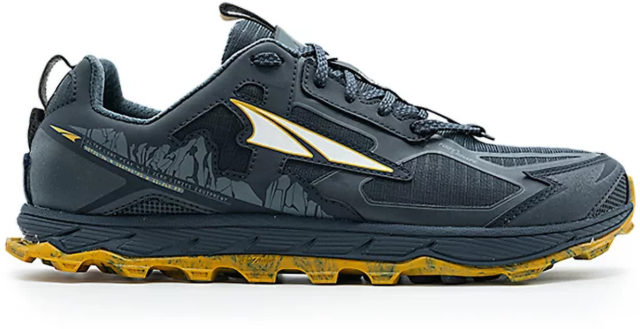
Intro
The Altra Lone Peak series entered the running world around 8 years ago as Altra’s flagship trail running shoe. Named for the rugged Lone Peak of the Wasatch Range, this shoe instantly became popular as an all-round trail shoe for everything from trail races to ultra marathons to long thru-hikes.
Like so many of Altra’s shoes, the Lone Peak has undergone many revisions over the years (and they now offer waterproof and mid-cut versions). The previous version 4.0 of the Lone Peak was one of my favorite Altra trail shoes thanks to its stable fit, solid traction, and moderate cushioning — all of which made it great for technical running with lots of scrambling and vertical gain.
The newest Lone Peak 4.5 looks very similar, with the primary updates being a tweaked upper construction and new midsole foam. Given that I got along really well with the Lone Peak 4.0, I was very curious to try the latest iteration.
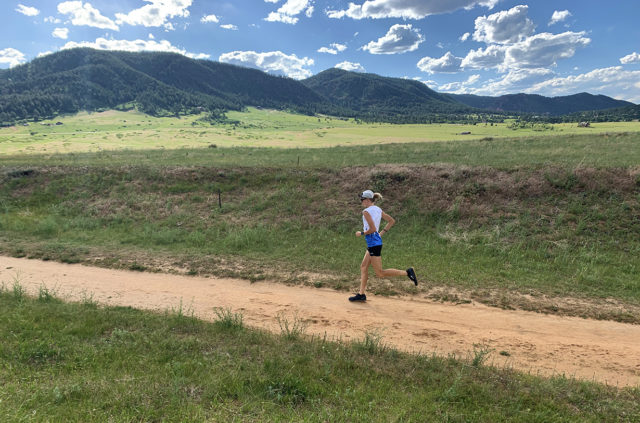
I’ve now spent around 150 miles running in the Lone Peak 4.5 on a variety of technical and smooth trails around Gunnison and Colorado Springs. While the updates appear subtle on paper, I think they are very noticeable on trail. Combined with Altra’s recent updates to shoes like the Superior 4.0 and Timp 2.0 (which sit on either end of the Lone Peak 4.5 in their lineup), I think those considering the Lone Peak 4.5 may now have some new things to keep in mind when picking their next Altra shoe.
Fit
As always, we highly recommend that you try on any shoe to get a sense of how it fits your feet. And in the case of the Lone Peak 4.5, I think that recommendation is extra important. With that said, I can speak to how the Lone Peak 4.5 fits my feet. For reference, I have a narrower foot with a medium-height arch, but I do prefer shoes that allow for a good amount of toe splay.

The overall fit is one of the main areas where I found the Lone Peak 4.5 to be less favorable than its predecessor — at least for my feet. The Lone Peak 4.0 had a fixed webbing loop on either side of the tongue, through which the laces were routed. While this feature was a bit polarizing among users of the shoe (some found it created a hot spot over the instep), I loved that it kept my narrow midfoot and heel secure, while still maintaining the shoe’s spacious toe box. This was particularly useful to me when running on off-camber and rocky terrain, which was where I thought the Lone Peak 4.0 excelled.
The Lone Peak 4.5 ditches that webbing in exchange for a more typical lacing design. For me, I think that’s a big part of why the 4.5 feel less secure and stable over technical terrain. For some, this could mean that the 4.5 may actually be more comfortable than the 4.0. Again, trying it on is going to be important.
The fit through the Lone Peak 4.5’s heel still feels very secure to me — as with the Lone Peak 4.0, I didn’t find the ankle collar to be too wide. The Lone Peak 4.5’s laces also now run farther down the upper, which Altra says helps when making micro-adjustments to the fit. In my experience, this difference to the lacing length does not significantly change how the shoe feels or fits my feet.
The Lone Peak 4.5 features Altra’s signature “FootShape” toe box, which has provided plenty of room for my toes to splay out. At least on my fairly narrow feet, the toe box is one part of the Lone Peak 4.5 that does feel nearly identical to the previous model.
Overall and on my feet, the Lone Peak 4.5 fits similarly to the old Timp 1.5, a great cushioned trail shoe in its own right, but one that just did not have the precise fit I need for more technical terrain.
Due to its more traditional lacing system, those with higher arches may find the fit of the 4.5 to be more accommodating than the 4.0, with its stiffer webbing reinforcement. Unfortunately for me, the removal of that webbing has made the Lone Peak 4.5 feel notably looser on off-camber trails. As is often the case with a new shoe, I think there will be some who prefer the fit and feel of the Lone Peak 4.5’s new upper vs. the 4.0, while others will not.
Heel-to-Toe Drop
Like all of Altra’s shoes, the Lone Peak 4.5 is a zero-drop shoe, meaning that the forefoot and the heel are the same height from the ground. This encourages more of a forefoot foot strike (rather than a heel-to-toe transition) and can take time to adapt to if you’re coming from conventional shoes with higher heel-to-toe drops.
Weight
At a stated weight of 298 grams (US Men’s 9), the Altra Lone Peak 4.5 is certainly on the heavier end of the spectrum for a trail shoe with a 25 mm stack height. The 4.5 reportedly gained 9 grams per shoe vs. the Lone Peak 4.0, which was already a heavy-feeling shoe. Unfortunately, the weight of the Lone Peak 4.5 became one of my main complaints during my time with it.
For me, this added weight makes the purpose of the Lone Peak 4.5 in Altra’s lineup a bit confusing. The new Timp 2.0, for instance, offers more cushioning, a fairly aggressive outsole, a surprisingly secure fit — and it’s notably lighter than the Lone Peak 4.5. For many people, I think that will make the Timp 2.0 more appealing in most running scenarios. And then Altra’s more minimal Superior 4.0 reportedly weighs a whopping 74 grams less per shoe vs. the Lone Peak 4.5.
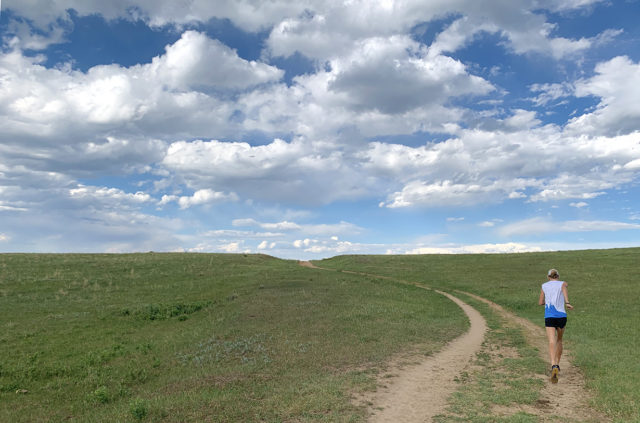
Of course, everyone’s priorities in terms of weight differ and there are some other shoes in this class like the Sportiva Bushido II and Topo Athletic Ultraventure that are similarly heavy. But if you’re looking to the moderate-cushion category primarily to get something that’s lighter than higher-cushion options, the Lone Peak 4.5 isn’t your best choice.
For reference, here are the stated weights of some notable shoes in the Lone Peak 4.5’s category, as well as the Altra Superior 4.0 and Timp 2.0, which sit on either side of it in the brand’s lineup. All stated weights are for a US Men’s size 9.
224 g / 7.9 oz — Altra Superior 4.0
263.6 g / 9.3 oz — Hoka Torrent 2
263.6 g / 9.3 oz — Topo Athletic Mtn Racer
266.5 g / 9.4 oz — Hoka Challenger ATR 5
280 g / 9.9 oz — Salomon Sense Ride 3
281 g / 9.9 oz — Altra Timp 2.0
289 g / 10.2 oz — La Sportiva Lycan II
294 g / 10.4 oz — Topo Athletic Ultraventure
298 g / 10.5 oz — Altra Lone Peak 4.5
298 g / 10.5 oz — La Sportiva Bushido II
306 g / 10.8 oz — Topo Athletic Terraventure II
Upper
The Lone Peak 4.5’s upper features a mix of thin, ripstop fabric and lots of overlays for support. The larger drainage ports at the toe and the heel help the shoe drain excess water better than version 4.0, while the strategic placement of the overlays in the upper has allowed the shoe to more easily flex and conform to my foot.
Overall, the Lone Peak 4.5’s upper feels more refined to me than the previous version. Due to the slightly tweaked placement of the overlays, the Lone Peak 4.5’s upper feels a bit less bulky and, in general, I think the upper is one area where the 4.5 feels better than the 4.0.
The Lone Peak 4.5’s upper also features attachment points for Altra’s 2-point Gaiter System (the Lone Peak 4.0 used their 4-point gaiter system). The Lone Peak 4.5’s toe bumper is pretty wide and has offered plenty of protection from kicking rocks, far more than a lighter shoe like the Altra Superior.
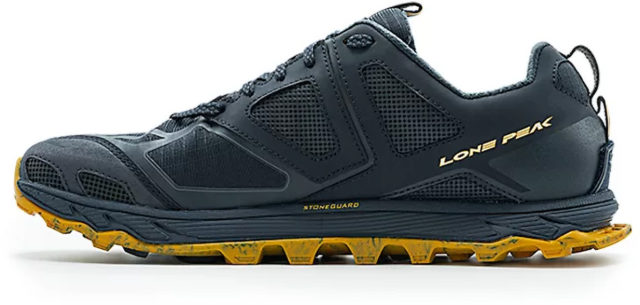
The heavier, leather-like overlays from the previous shoe, while no longer as big down the sides of the shoe, are still mostly present around the laces and probably contribute to some of the substantial weight of the Lone Peak 4.5 (especially compared to the minimal upper of the Altra Timp 2.0). The Lone Peak 4.5’s upper material itself did not wear prematurely or cause me any issues with hot spots or blistering. I found that the upper was warm enough to run in the snow, but if that’s a priority, you should check out the waterproof, “RSM” versions of the Lone Peak.
I did the majority of my running in this shoe in dry, warmer conditions. The upper breathes a bit better than the previous version in warmer weather and I never found that my feet got too hot in the shoes. With that said, the hottest weather I ever ran in with these shoes was around 75º F / 24º C, and in very dry air. Given the substantial amount of not-super-breathable overlays covering the shoe, I think it’s safe to assume that it won’t be the most breathable shoe when things get really hot and humid.
Midsole and Cushioning
One of my main issues with the Lone Peak 4.0 was that its midsole packed down and lost most of its springy rebound within just 20-40 miles in the shoe. The Lone Peak 4.5 maintains the same 25 mm stack height and “StoneGuard” rock plate as the 4.0, but uses an updated version of Altra’s A-bound foam. Overall, I think the 4.5’s midsole will be an improvement for most people — it’s proven to be much more resilient over time.

The Lone Peak 4.5’s rock plate, fairly bulky outsole, and firm 25 mm of cushioning have provided me ample protection on rocky trails. As with the previous version of the shoe, I didn’t find myself gingerly trying to avoid sharp rocks when wearing the Lone Peak 4.5 on rocky terrain.
With that said, the Lone Peak 4.5 is not what I’d call a particularly “lively” shoe — its cushioning feels somewhat “flat,” especially compared to something like the Hoka Speedgoat, Hoka Torrent, and Altra Timp 2.0. While it’s more durable over time vs. the previous version, the Lone Peak 4.5’s midsole does not make it feel particularly fast, especially when you also factor in its weight.
With that said, the shoe doesn’t have the same life or plush cushioning underfoot that I would expect from a heavier shoe. While more durable, this midsole does not have the kind of energy return to balance its heftier weight of 298 grams. This is not a decline in quality from the previous version, which also suffered from a midsole that did not feel particularly quick or snappy, while still feeling thinner than a lot of other options in this weight category. While the Lone Peak’s stack height is 25 mm, it feels a lot thinner than the similarly cushion Hoka Torrent 2 (stack height: 23 mm heel / 18 mm forefoot). Granted, the Lone Peak series has always had a 25 mm stack height, though many people have noticed that the midsoles of the Lone Peak 4.0 and 4.5 have felt a lot thinner than older models of the Lone Peak.
Outsole and Traction
The Lone Peak 4.5’s outsole is completely unchanged from version 4.0. It uses Altra’s proprietary Maxtrac rubber compound with Altra’s multi-directional “Trailclaw” lug pattern, and the outsole has offered plenty of traction on dry trails and looser conditions. The Lone Peak 4.5’s outsole tread is definitely on the more aggressive end of the spectrum and has only really come up short in terms of grip on wet logs or rocks, where the Maxtrac rubber compound fails to grip as well as some other compounds, such as the Vibram MegaGrip rubber found on the Altra King MT 2 (MegaGrip continues to be one of the grippiest rubbers we’ve used). If you spend the majority of your time on predominantly wet, rocky / rooty trails, I would consider the more mud-specific King MT 2 over the Lone Peak 4.5.
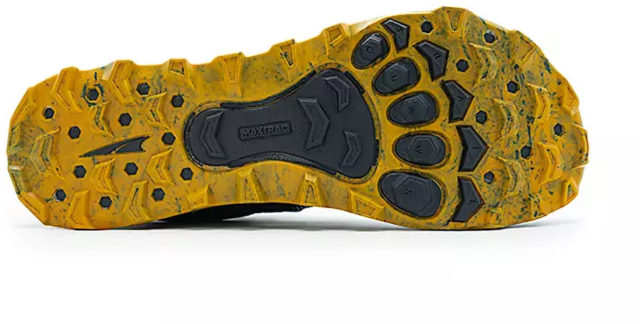
Unfortunately (and unsurprisingly, given it’s the same outsole), I have found the durability of this outsole to be unimproved from version 4.0. In the previous version, the outsole showed significant signs of wear at around 200 miles (the lugs were noticeably shorter, with one fully ripping off). At approximately 150 miles, the Lone Peak 4.5 is showing a similar pattern of wear. I imagine that the outsole would last longer if you were using it primarily on softer ground, as opposed to the rocky and dry trails that I usually run on.
When compared to the much lighter Altra Superior 4.0, the Lone Peak 4.5 out-performs it in terms of traction on more technical terrain and in looser conditions, while feeling notably more sluggish on fast and smooth trails. As I mentioned, the Lone Peak 4.5 doesn’t inspire the same boulder-hopping confidence as the grippier, lower cushion, more secure-fitting Altra King MT 2. Compared to the Hoka Torrent and Salomon Sense Ride series, the Lone Peak 4.5’s outsole doesn’t offer as much grip on rocks and roots (which I’d mostly attribute to differing rubber compounds), though the Lone Peak 4.5 is better for looser conditions like mud and snow. Overall, I think the Lone Peak 4.5’s performance on really rocky terrain that involves a lot of scrambling could be further improved if Altra went with a stickier rubber.
On The Trail
Having used the Lone Peak 4.5 on a variety of different types of trails, I think it makes the most sense on technical, mostly dry trails, where the heavier weight and not-very-springy midsole of the shoe aren’t as important. That said — and at least for my feet — the tweaked upper and fit of the 4.5 has made me feel less surefooted on very technical terrain than the 4.0. So while the 4.5 performs best on technical terrain, it’s still not my personal go-to shoe for more rugged trails. This is unfortunate since the previous Lone Peak 4.0 (which fit my feet more securely) was my favorite Altra shoe for big days in the mountains and technical terrain. There’s a chance some may actually prefer the 4.5 to the 4.0 in this scenario, as a lot of this depends on your feet. But for me, that wasn’t the case.
Due to its weight, aggressive outsole, and minimal rebound produced by its midsole, the Lone Peak 4.5 does not feel very smooth or fast to me on flatter, less technical trails (e.g., the ones shown in the photos of this review). For that sort of running, I would definitely prefer a faster, more efficient shoe like the Altra Superior 4.0, or the Timp 2.0 for longer runs.
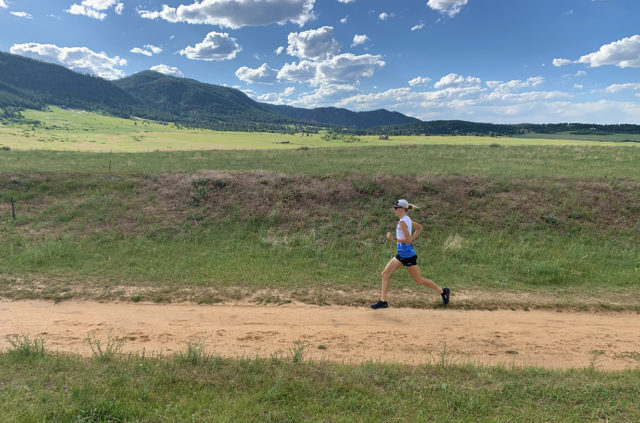
One area where I did enjoy running in the Lone Peak 4.5 was a 15-mile loop through Red Rock Canyon Open Space in Colorado Springs. The combination of crushed gravel paths, lots of runnable vertical gain, and some technical elements gave me glimpses of what I enjoyed about the previous models. With that said, I think I still would’ve preferred the slightly lighter weight and more stabilized fit of the previous iteration.
Overall, the Lone Peak 4.5 seems best suited to more technical trail running and hiking, but just how well it does that for you will depend greatly on how it fits your feet.
Durability
After approximately 150 miles in the Lone Peak 4.5, it’s holding up about as well as I had expected, given my experience with the last version and the updates made to the new one.
The Lone Peak 4.5’s outsole is wearing down pretty fast, but not enough to make it unusable and it’s nothing different than what I experienced with the Lone Peak 4.0. The 4.5’s upper seems well constructed and is showing minimal signs of wear — much like the previous version, I haven’t had a problem with the upper’s durability. The midsole has now begun to pack out a bit, but this is still a major improvement over the previous version, which I could feel breaking down almost immediately (within ~50 miles).
It would be great to see Altra switch up the outsole of the Lone Peak to a more durable material (or a grippier one that better justified quicker wear), and maybe shed a gram or twenty while they’re at it. With that said, I do think that this version of the Lone Peak 4.5 is an overall better-made shoe and the midsole, in particular, has proven to be notably more resilient than the previous iteration.
Who’s It For?
In my opinion, I think that the Lone Peak 4.5 will appeal most to those who were fans of the 4.0 but who would’ve preferred a longer-lasting midsole and who don’t mind a bit of extra weight in a trail shoe. The improvements in midsole durability will probably come as a welcome update to those using the shoe for long thru-hikes or ultra races. That said, even if you loved the fit of the Lone Peak 4.0, I’d highly recommend trying on the 4.5 before buying as the fit differences are important.
As a running shoe, the Lone Peak 4.5 feels best suited to more technical terrain where a low weight is not as important and you can take advantage of its aggressive outsole. Just how well it works for that sort of running will primarily depend on how it fits your feet and how dry vs. wet the terrain is. The Lone Peak 4.5 grips best on drier rocks and roots, though it’s pretty good on looser conditions for a non-mud-specific shoe. And if you liked the Lone Peak 4.0 as more of a hiking shoe than a true running shoe, I think there’s a lot to like with the new version, thanks to its improved midsole and potentially more accommodating upper.
For those looking for a versatile trainer that is both fast enough for workouts and also comfortable enough for long runs, I think there are many other options out there that do this far better than the Lone Peak 4.5. Shoes such as the Altra Timp 2.0, Salomon Sense Ride 3, and Hoka Torrent all deliver more comfortable cushioning at a lower weight, making them better choices in that scenario.
Bottom Line
The Altra Lone Peak 4.5 maintains much of what people have come to expect of a Lone Peak: an aggressive outsole, moderate cushioning, good rock protection, and a pretty burly, reinforced upper.
Interestingly, as Altra’s lineup has expanded (and improved) in recent years, it’s become increasingly difficult to easily identify where the Lone Peak excels and fits into the lineup. If you primarily want a really fast shoe for running on smoother trails, the far lighter Superior 4.0 makes more sense. If you want comfortable cushioning for longer days (even on fairly technical terrain), the lighter, more agile, and more plush Timp 2.0 is better for that. And if you specifically want a precise, grippy shoe for runs with lots of scrambling and / or mud, that’s what the King MT 2.0 is for.
Due to all of those shoes’ differences in terms of cushioning — and especially fit — the Lone Peak 4.5 will still work better than the others for certain people. It’s more protective than the Superior 4.0, offers better traction than the Timp 2.0 in most conditions, and is roomier and more cushioned than the King MT 2.0. But whereas those three shoes all have very clear scenarios in which they excel, the Lone Peak 4.5’s ideal end-use is a bit less obvious.
All that said, if you spend a lot of time running (or hiking) in more technical terrain, the Lone Peak 4.5 still warrants consideration — I’d just highly recommend trying it on before buying.
